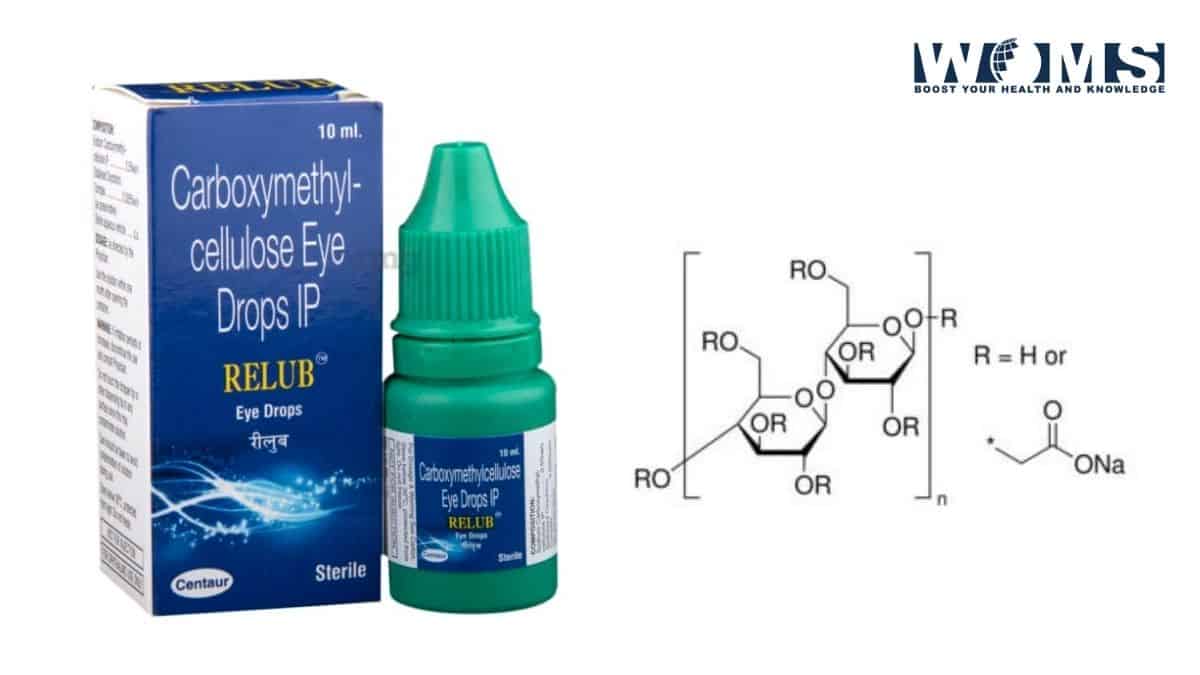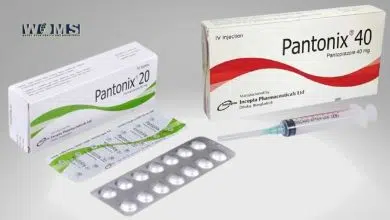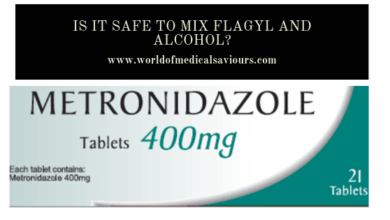Carboxymethylcellulose Eye Drops

Carboxymethylcellulose eye drops are a sterile ophthalmic solution. It is used as a lubricant to treat dry eyes. There are various causes of dry eyes such as excessive computer/laptop use, wind, heating/air-conditioning, sun, and certain medications.
Carboxymethylcellulose eye drops help keep the eye moist and protect it from any infections or injury. However, these eye drops have a mild side effect profile. If the symptoms worsen or persist, it is best to consult with your health care provider.
Active Ingredients
Carboxymethylcellulose sodium 0.5%
It also contains magnesium chloride, calcium chloride, sodium chloride, potassium chloride, purified water, and sodium lactate. Hydrochloric acid or sodium hydroxide may be present in small amounts to adjust the pH.
Uses of carboxymethylcellulose eye drops
We can treat the following conditions with carboxymethylcellulose eye drops:
- Dry eyes
- Keratoconjunctivitissicca (Inflammation and dryness in cornea and conjunctiva)
- Irritation and discomfort associated with lens wear
Causes of dry eyes
There are several causes that can specifically result in dry and irritated eyes:
- Excessive computer or laptop usage
- Using contact lenses
- Laser eye surgery (LASIK)
- Allergies in the eye
- Certain medications
- Pregnancy
- Women recieving hormone replacement therapy
- Reading
- Weather conditions (such as wind, sun, and cold winds)
Forms of medication available
- Drops (5 mg)
- Ointment (10 mg)
How carboxymethylcellulose eye drops work?
Carboxymethylcellulose eye drops work as a lubricant to ease the dryness of the eyes. They act as natural tears. Furthermore, they stabilize the natural tear film and providetemporary relief from irritation and burning in the eyes.
Dosage
Use 1 to 2 drops into each eye, 2 to 4 times per day.
Directions to use
Follow all the directions given on the leaflet that comes with thecarboxymethylcellulose eye drops. If you have any queries, ask your doctor or physician from time to time to guide you accordingly.
Carboxymethylcellulose sodium drops
- Wash your hands first.
- Take care not to touch the tip of the dropper to any surface or your eye in any case to avoid the risk of contamination.
- Tilt your head back while lying down, look up and pull the lower eyelid down to create a pouch.
- Instill 1-2 drops of sodium carboxymethylcelluloseeye drops into the pouch.
- Release the eyelid gently and close your eyes at the same time for 1-2 minutes.
- Dab off the excess drops with a clean tissue.
- Repeat the same procedure for the other eye.
- You can use the sodium carboxymethylcellulose drops as often as needed and as long as required.
Carboxymethylcellulose sodium ointment
- Wash your hands before using the medication.
- Avoid touching the tip of the tube with any contaminated surface.
- Tilt your head back, pull your lower eyelid to create a pouch.
- Squeeze a small amount of the sodium carboxymethylcelluloseointment into the pouch carefully.
- Close your eyes gently and roll your eyes to spread the ointment evenly across the eye.
- Clean off any excess product with a clean tissue.
- You can use the sodium carboxymethylcellulose ointments 1-2 times daily. If you are advised to use it once daily, use it at night before going to sleep.
Precautions to use carboxymethylcellulose eye drops
- Do not use the carboxymethylcelluloseeye drops if they have changed colour or become cloudy. Some eye drops have a milky appearance. It is okay to use them as long as they do not change colour.
- Follow the instructions carefully. Some eye drops should be shaken before use. If your product needs to be shaken before use, in that case, go ahead as directed.
- Check to make sure the seal is intact before use. In case the seal is broken, do not use the medication.
- Do not share this medication with other people to limit the spread of infection from one person to another.
- Replace the cap after use.
- When using the carboxymethylcellulose eye drops, place one finger at the side of your nose. This will prevent the medication from going elsewhere and will remain in the eye.
- If you wear contact lenses, consult with your doctor whether you should use the eye drops or not. Remove the lenses before using eye drops. Some eye drops can be used with contact lenses. Use the lubricant as directed.
- If you are allergic to the medication, inform your doctor before using the eye drop.
- Do not drive or perform any activity which requires a clear vision, given that this product can cause temporary blurred vision.
- Use eye drops before ointments to allow the eye drops to enter the eye.
- Do not ingest the medication. The carboxymethylcellulose eye drops are for external use only. Otherwise, it can result in overdosage.
- Keep out of the reach of children and pets like cats & Dogs.
Side Effects of carboxymethylcellulose eye drops
Most people using sodium carboxymethylcellulose eye drops do not experience any side effects. Nevertheless, side effects are prone to occur in some population, and these include:
- Blurred vision
- Burning and irritation in the eye
- Redness in the eye
Interaction with other medications
If you use any other medication in the eye, always inform your doctor or pharmacist before using carboxymethylcellulose eye drops. Keep a list of all the medicines with you and show it to your doctor. Above all, do not start or stop any medication by yourself without consulting your doctor. When you use the carboxymethylcellulose eye drops, wait for about 5 minutes before using any other medication.Also, inform your doctor about any other health conditions you are suffering from.
Drugs that increase the severity and risk of side effects
- Osmotic diuretics (such as Acetazolamide)
- Alloin
- Amiloride
- Benzthiazide
- Bisacodyl
- Bumetanide
- Canagliflozin
- Castor oil
- Loop diuretics (such as Furosemide)
- Thiazide diuretics (such as Hydrochlorothiazide)
Drugs that decrease the therapeutic effect of sodium carboxymethylcellulose
- Aclidinium
- Amantadine
- Amiodarone
- Amlodipine
- Aripiprazole
- Atracurium
- Atropine
- Benzatropine
- Biperiden
- Butorphanol
- Carfentanil
- Carvedilol
- Desipramine
- Ethosuximide
- Felodipine
How long can carboxymethylcellulose eye drops be used?
Use the carboxymethylcellulose eye drops as directed by your physician. Eye drops are generally meant to be used for a limited amount of time. Using them for an extended period can compromise the health of your eye. In summary, these eye drops are meant for temporary solutions of dry eyes or keratoconjunctivitis and not for long-term use.
Discard those lubricating eye drops which come without preservatives within 12 hours after opening without delay.
Mixture products:
Some mixture products provide better efficacy in treating dry and irritated eyes. These include:
- Carboxymethylcellulose sodium (1.0%) plus glycerine (0.25%)
- Carboxymethylcellulose sodium (5 mg) + Mineral oil (425 mg) + Petrolatum (573 mg)
- Carboxymethylcellulose sodium (0.25 %) + Hypromellose (0.3 %)
When to visit the doctor
Your doctor may prescribe you carboxymethylcellulose eye drops in the view that their benefits are greater than the risk of side effects. However, inform your doctor if you notice any of the following symptoms or if the side effects worsen:
- Eye pain
- Redness in the eye
- Allergic reaction to the product (although rare, but it can occur)
- Change in vision
Overdosage
Carboxymethylcellulose eye drops can be harmful if swallowed. If someone has overdosed on the medication, contact your doctor as soon as possible or the poison control center.
Overdosage means more frequent use of the drug than your doctor prescribed or used in higher doses than recommended.
Frequently asked questions
What is carboxymethylcellulose eye drops?
Carboxymethylcellulose eye drops are eye lubricant drops that help ease the irritation and dryness in the eyes. In addition to this, you can use these eye drops to treat keratoconjunctivitssicca.
How to store carboxymethylcellulose eye drops?
Store the eye drops in a cool and dry place, protected from heat and sunlight. The surrounding temperature should be no more than 25 degrees Celsius. Do not use it after the expiry date. Use within four weeks after opening.
Is carboxymethylcellulose a safe medication?
Yes, it is a safe medication. It is available for external use only and is not harmful unless ingested. However, it may cause burning, irritation, redness, and stinging in some patients’ eyes. Immediately contact your physician or health care provider if the symptoms worsen with time or persist.
How to use carboxymethylcellulose eye drops?
ash your hands first. Lie down and tilt your back. Now, pull your lower eyelid down to create a pouch. Instill 1 or 2 drops into the pouch and close your eyes gently for 1 to 2 minutes. Clean off the excess fluid with a clean tissue.
Do not ingest the eye drops as they are recommended for external use only. Taking them orally can be dangerous. If someone ingests the drops, call the doctor or poison control center as soon as possible.
What do I need to tell my doctor before using carboxymethylcellulose eye drops?
Inform your doctor about any allergic reactions to carboxymethylcellulose sodium before starting these eye drops. Tell your health care provider about the allergic symptoms and signs you experienced previously.
How to dispose of the medication?
When disposing of the medication, discard the product appropriately. Do not flush or pour it into the drain until instructed. Contact your physician or local waste disposal company for instructions on how to discard the product safely.
Do I need a prescription for carboxymethylcellulose eye drops?
Carboxymethylcellulose is available as an over-the-counter medication without any prescription by the doctor. You can go to your nearby pharmacy and purchase this medication when needed.
What is the shelf life of carboxymethylcellulose eye drops?
The shelf life is about 1 to 2 years,i.e., use then effectively within 1 to 2 years of manufacturing. However, consume them within four months of opening as there can be an increased risk of contamination if used for more than four months.
What are the contraindications of carboxymethylcellulose?
Contact lens users should take extra care when using these eye drops. Consult your doctor or pharmacist before starting these eye drops. Carboxymethylcellulose eye drops can irritate and burning in the eyes if not compatible with lenses. Moreover, people allergic to sodium carboxymethylcellulose should not use this product as it can cause a severe allergic reaction in the eye.
What if I miss a dose?
If you miss a dose or forget to take one, use the drops as soon as you remember. If it’s time for the next dose, skip the previous one. Never take a double dose at a time. If you forget doses often, set an alarm as a reminder.
Can I carry this medication with me while travelling?
Yes, you can carry carboxymethylcellulose eye drops with you while travelling but do not put them in your check-in baggage. You can keep it in your hand-carry.
Can I use these eye drops in pregnancy?
Yes, carboxymethylcellulose eye drops are absolutely safe to use in pregnancy. Although this may be true, there is no evidence available that shows any risk associated with using these eye drops in pregnancy or even in lactating mothers.
Can I use castor oil along with sodium carboxymethylcellulose?
No. Castor oil is contraindicated when using carboxymethylcellulose eye drops simultaneously. Castor oil can increase the risk and severity of side effects.
Are lubricating eye drops safe to use?
Yes, lubricating eye drops are safe. Some eye drops contain preservatives that help prevent the growth of bacteria or other microorganisms. Doctors recommend not to use eye drops containing preservatives more than four times a day.
Whereas some eye drops do not contain any preservatives. Patients suffering from moderate or severe infections in the eye can use them. The preservative-free eye drops can be used more than four times a day.
What other lubricants can I use for dry eyes?
Systane, Thera tears, Lumify, Visine, Refresh tears, Blink tears, and Clear eyes are some lubricating eye drops to treat dry eyes and irritation. In addition to this, castor oil is a helpful remedy for the dryness of the eyes.




